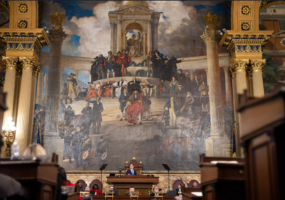 Tomorrow, Gov. Josh Shapiro will deliver his second annual budget address in a Joint Session of the General Assembly. But the address will make history in that it will be delivered in an unusual location – the Capitol Rotunda – rather than its traditional location in the House Chamber, due to ongoing construction and maintenance work to address a water leak in the ceiling. Our Vice President and General Counsel Megan Martin dug into the archives to chronicle the history of this yearly, fiscally focused address.
Tomorrow, Gov. Josh Shapiro will deliver his second annual budget address in a Joint Session of the General Assembly. But the address will make history in that it will be delivered in an unusual location – the Capitol Rotunda – rather than its traditional location in the House Chamber, due to ongoing construction and maintenance work to address a water leak in the ceiling. Our Vice President and General Counsel Megan Martin dug into the archives to chronicle the history of this yearly, fiscally focused address.
The budget address dates to 1921, when then-Governor William C. Sproul delivered the precursor to what would become a highly anticipated annual event.
At least as far back as the Civil War, it was customary for governors to address the General Assembly immediately upon their inauguration or on the day it assembled, typically by way of a written message.
Indeed, as the Harrisburg Telegraph reported at the time of Gov. Sproul’s address: “For generations governors of Pennsylvania have contented themselves by sending formal messages…to the general assemblies, but…Governor Sproul asked for the privilege of speaking to the legislators, many of them former colleagues in the Senate.”
Gov. Sproul’s sweeping address – which spanned 26 pages in the Legislative Journal – addressed the state’s finances, tax plan, revenues, education, transportation, constitutional and statutory revisions, and many other topics.
Two years later, the Administrative Code of 1923 formalized the state budget process and charged the Secretary of the Commonwealth with preparing a budget. As a result, for the first time, the governor could present to the General Assembly his comprehensive estimate of income and expenditures.
On January 6, 1925, then-Governor Gifford Pinchot made the first gubernatorial budget address pursuant to the new Code. Since then, governors throughout the Commonwealth’s history have carried on this tradition, which had its beginnings at the start of the twentieth century.
Later, revisions to the Code created the Department of Revenue and transferred the budget preparation responsibilities to a newly created Budget Secretary within the Governor’s Office. These changes, and others, comprised the Administrative Code of 1929 and the Fiscal Code, which are the basis for state operations to this day. Today, the governor is required to submit a state budget to the General Assembly.
Further, Constitutional changes in 1959 provided for annual sessions of the General Assembly; before then, Pennsylvania had operated a two-year budget cycle. The Code was revised again in 1961, and as a result, the Commonwealth has had annual budgets and a fiscal year with a start date of July 1 ever since.
Under current law, the governor must submit his budget to the General Assembly “as soon as possible after the organization of the General Assembly, but not later than the first full week in February of each year, except in the case where a Governor has been elected for his first term of office and then no later than the first full week in March.”